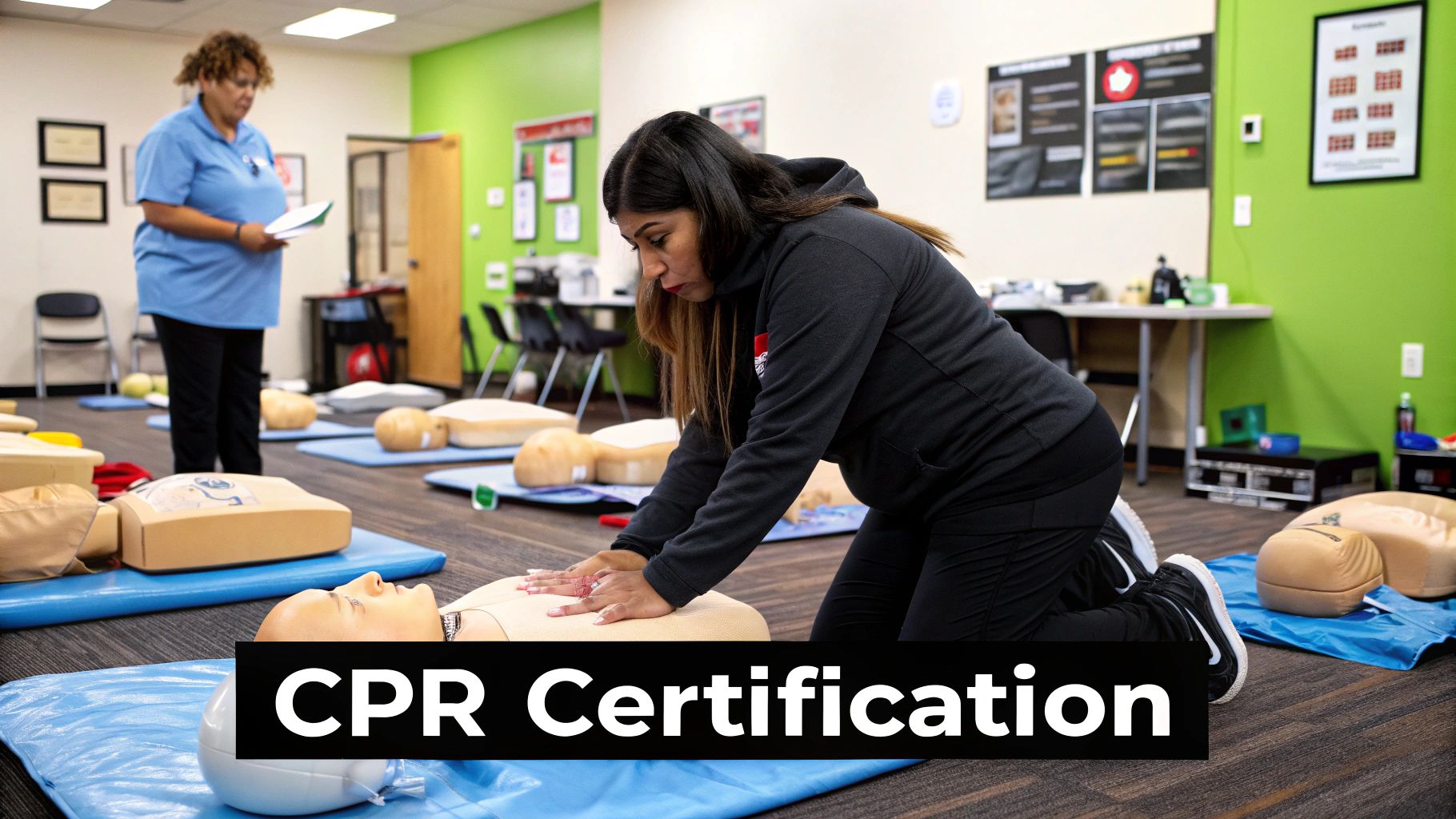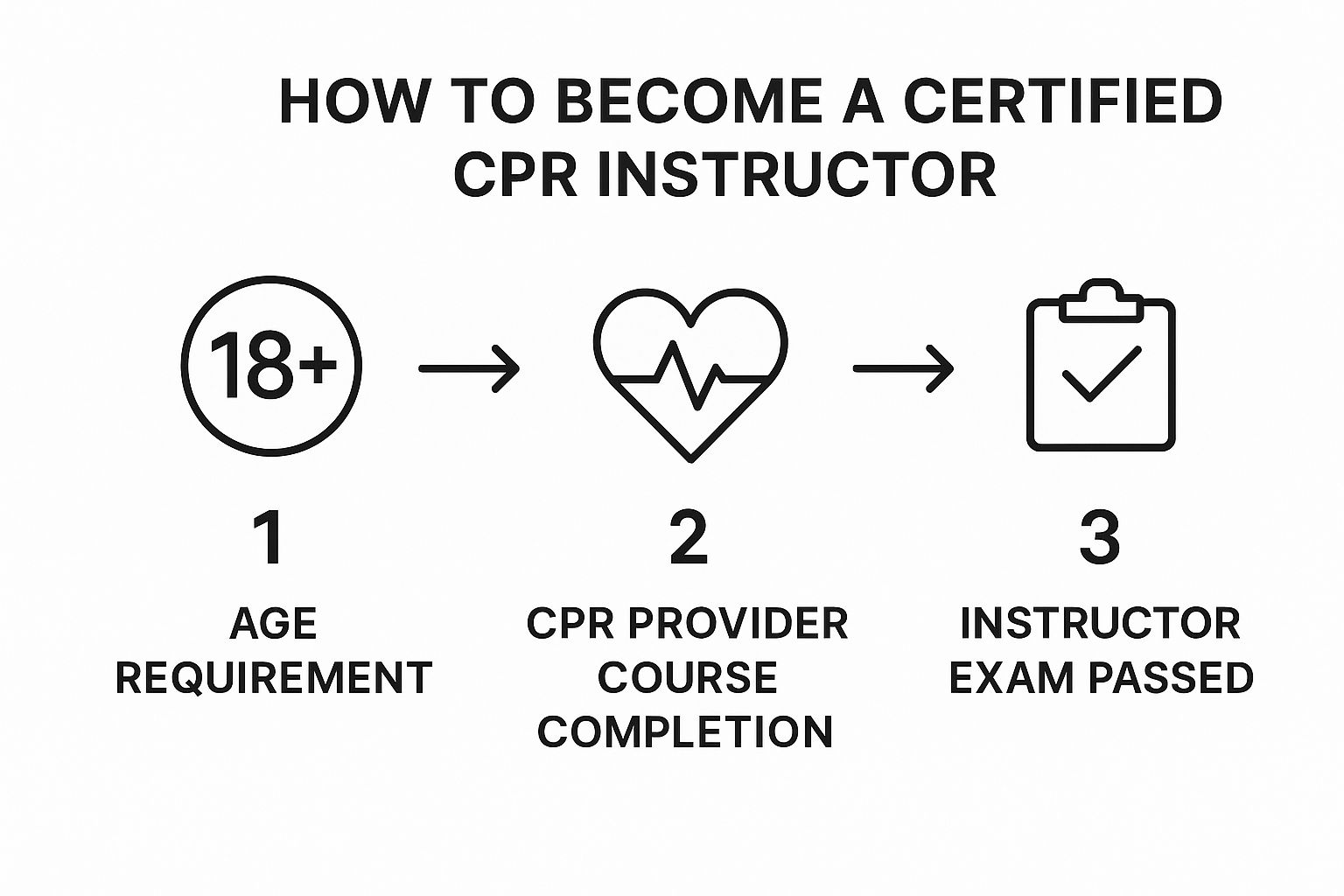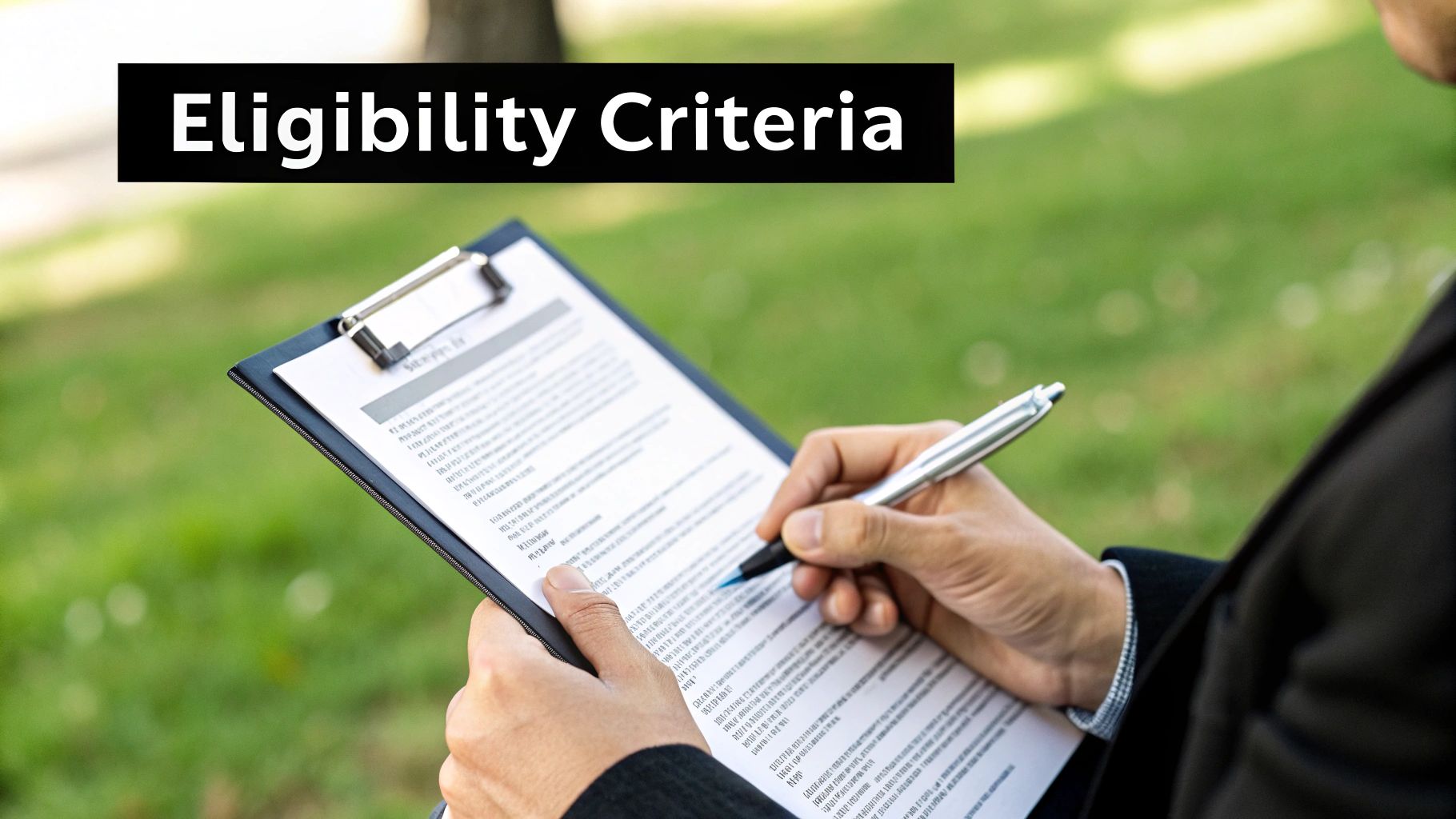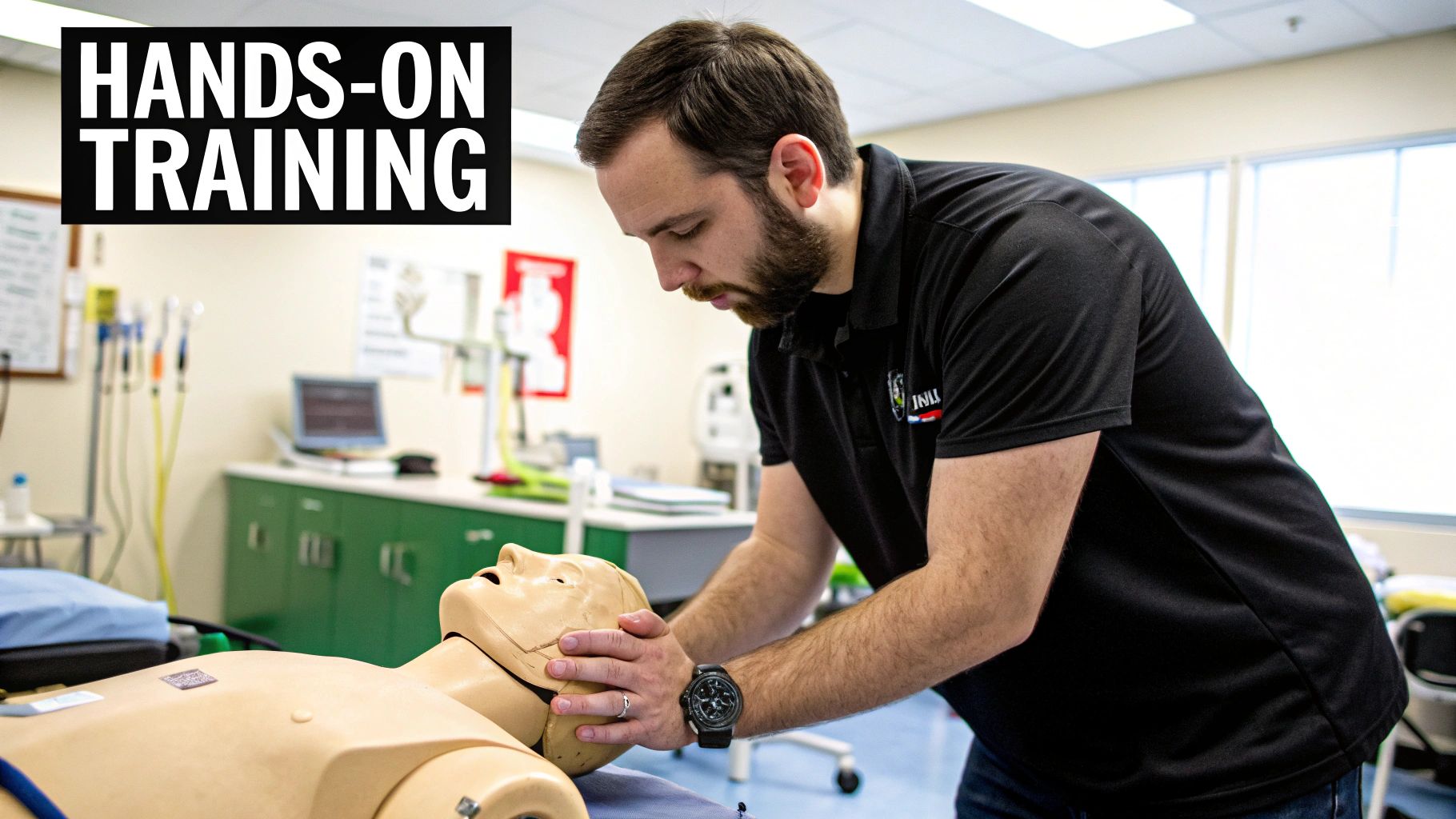So, you're ready to teach others how to save a life? That’s fantastic. But before you can lead a classroom, you’ve got to prove you’ve mastered the skills yourself. Think of this first step as building the foundation for your entire teaching career. It all kicks off with meeting a few non-negotiable prerequisites.
Meeting The Core Instructor Prerequisites
You can't just sign up for an instructor course on a whim. The major organizations that set the standards for CPR training, like the American Heart Association (AHA) and the American Red Cross (ARC), need to know you have the competence and commitment to teach their material effectively. It's all about ensuring quality and credibility from the ground up.

Why Provider Certification Is A Must
This is the big one. Both the AHA and the ARC are strict about this: instructor candidates absolutely must hold a current provider certification in the discipline they want to teach. For most people reading this, that means having a valid Basic Life Support (BLS) certification.
It just makes sense, right? How can you teach high-quality CPR if you aren't already proficient in performing it yourself? Your provider card is your proof. It shows you know the latest guidelines, can deliver solid compressions, and manage an airway like a pro. You've been in the student's seat, so you get the material from their perspective.
The core principle is simple: you can't teach what you don't know. Holding a current provider certification ensures that every instructor has a strong, up-to-date understanding of the life-saving techniques they are responsible for teaching.
Here's a quick snapshot of the essentials you'll need to have in order before you even think about applying for an instructor course.
Prerequisite Checklist For Aspiring CPR Instructors
Having these pieces in place shows training organizations that you're a serious candidate who's ready for the responsibility of teaching.
Foundational Requirements To Begin
On top of holding a valid provider card, you'll need to check a couple of other boxes.
First is the age requirement. Most training bodies, including the AHA and ARC, require instructor candidates to be at least 16 or 18 years old, though this can vary slightly by course.
Next, while it’s not always a formal line item, having real-world experience is a massive plus. Maybe you’ve worked in healthcare, as a first responder, or as a dedicated volunteer. This kind of background adds a layer of authenticity to your teaching and lets you share stories that make the material stick.
At the end of the day, the path is clear: earn a current CPR certification, then complete an instructor course through an accredited organization. This process, backed by industry research and standards, guarantees that every instructor has a verified skill set before they stand in front of a class.
For a complete breakdown of the entire journey, check out our guide on how to become a CPR instructor.
Finding the Right Instructor Training Program
So you’ve ticked off all the prerequisites. Awesome. Now comes the big decision: choosing the right instructor training program. This isn't just about getting another certificate to hang on the wall. The organization you align with will shape your teaching style and career path for years to come.
The two heavyweights in this arena are the American Heart Association (AHA) and the American Red Cross (ARC). Each brings a unique flavor to the training world.
Your choice often boils down to where you see yourself teaching. The AHA is the gold standard in hospitals and clinical settings, respected for its rigorous, science-first curriculum. On the other hand, the ARC is a household name in community and corporate training, known for its accessible, user-friendly materials.
This image gives you a bird's-eye view of the path you'll take, no matter which organization you choose.

As you can see, it's a clear progression: meet the basic requirements, pass the instructor course, and get monitored. Simple on paper, but picking the right program is where the real work begins.
Comparing The Industry Leaders
When you’re learning how to become a certified CPR instructor, you have to weigh the AHA against the ARC. Here’s a quick breakdown of what sets them apart:
- Teaching Philosophy: The AHA uses a "practice-while-watching" video format. This ensures every class is taught the exact same way, which is critical for consistency in healthcare. The ARC tends to offer instructors a bit more flexibility in how they deliver the material.
- Curriculum Design: AHA courses are built on a deep foundation of the latest resuscitation science, with every detail meticulously updated. ARC programs are known for being incredibly straightforward and effective, making them perfect for lay rescuers who need clear, simple instructions.
- Instructor Support: Both provide online portals with teaching resources, but their local support networks can feel very different. I always tell aspiring instructors to research the local Training Centers for both organizations. The level of support you get can make or break your first year.
What To Look For In A Quality Course
Don't just pick a brand; pick a specific course that will set you up for success. A quality instructor program is much more than a long lecture.
Look for a small instructor-to-student ratio. You need personalized feedback when you're learning to teach. You should also demand tons of hands-on practice. If you're not on your feet running mock scenarios, practicing your delivery, and learning how to correct common student errors in real-time, you're in the wrong class.
A great instructor course doesn't just teach you what to say; it teaches you how to teach. It's about building your confidence to manage a classroom, handle tough questions, and adapt to different learning styles on the fly.
Costs And Time Commitment
Let's get practical and talk about time and money. The investment here is a key factor for most people.
Instructor course fees can range from a few hundred to over a thousand dollars, depending on the organization and even your geographic location. This cost typically covers your initial training class, essential course materials, and the final monitoring session.
As for your time, expect to complete an online module before you even show up for the in-person class. The classroom portion itself usually lasts one to two full days. Be realistic about what you can commit to. Choosing the right program is an investment, so pick one that aligns with your budget and, more importantly, your long-term goals as a lifesaver and educator.
What to Expect in Your Instructor Course
So, you’ve signed up. What happens now? This is where the real work begins. Your CPR instructor course isn't just another lecture—it's an immersive experience designed to turn you from a skilled provider into a confident educator. Think of it as boot camp for teaching people how to save lives.

You definitely won't be just sitting and listening. The curriculum is a mix of in-depth classroom instruction, sharpening your own skills, and—most importantly—a ton of practice teaching. Expect to spend a lot of time on your feet, leading mock classes and figuring out how to manage a room full of different learners.
This hands-on approach is absolutely essential. You’ll be evaluated on how clearly you can explain complex techniques, give helpful feedback, and adapt your teaching style to meet students where they are.
Mastering the Art of Instruction
Your course will give you the foundational teaching skills you need to get started. But to really become a great instructor whose students remember what to do in an emergency, you have to understand how people learn.
Diving into the psychology of adult education can make a massive difference in your effectiveness. You can find some excellent strategies for training staff for impact and retention that will give you a deeper understanding of how to make your lessons stick.
The course itself will likely run for a few days. Most programs span anywhere from two to four days, covering everything from adult and pediatric CPR techniques to teaching methodologies and the necessary paperwork.
The goal isn't just to make you an expert in CPR; it's to make you an effective communicator. The best instructors can break down the most stressful situations into calm, clear, and actionable steps.
Core Competencies and How You'll Be Evaluated
Throughout the course, you'll be watched closely for several key skills. These are the things that separate an average instructor from a great one.
- Skill Proficiency: You have to demonstrate flawless CPR and AED skills, even when you're under pressure.
- Instructional Clarity: Can you explain the "why" behind every step in a way that’s simple and easy to remember?
- Classroom Management: You’ll learn how to keep your students engaged, manage the clock, and handle those tricky off-the-wall questions.
- Constructive Feedback: A huge part of the job is correcting someone’s technique without discouraging them. It’s a delicate balance.
Getting Ready for Your Final Exams
Everything leads up to a final written exam and a hands-on skills evaluation. The written test will cover course material, teaching strategies, and administrative policies. Don’t skim your instructor manual—study it thoroughly.
For the practical evaluation, you'll teach a segment of a CPR class while the trainers observe. They're looking at how you present information, demonstrate the skills, and correct your "students." The key is to relax and teach with confidence. They want to see that you can not only do the skills but also inspire that same confidence in others. Passing this is the final step to proving you’re ready to train the next wave of lifesavers.
Staying Sharp: How to Maintain Your Instructor Certification
Earning your CPR instructor certification is a huge milestone, but it’s definitely not a one-and-done deal. Think of it like a professional license—it needs to be maintained to prove you're still sharp, effective, and up-to-date. This ongoing commitment is what keeps you credible in the classroom.
Your instructor status isn't for life; it comes with an expiration date, which is typically two years. Once that date approaches, you’ll need to go through a recertification process.
This isn't just about paperwork. It’s about showing that you’re still actively teaching and that your own provider-level skills are current. Organizations like the AHA and Red Cross want to see that you're not just holding onto a title but are an active part of the chain of survival. It’s all about demonstrating continued competence and engagement in the field.
The Recertification Process
The good news is that recertification is pretty straightforward for active instructors. You won’t have to sit through the entire initial instructor course again. Instead, you'll usually attend a much shorter instructor renewal class. This is where you’ll get caught up on any curriculum changes or science updates.
Here’s a quick breakdown of what that usually looks like:
- Teaching Requirement: You’ll need to show proof that you've taught a minimum number of classes. A common benchmark is four classes over two years.
- Provider Status: Your own BLS or other provider-level certification must be current. If your own renewal is coming up, our guide to CPR and First Aid renewal is a great resource.
- Update Training: You must complete any official guideline updates released by your certifying organization, like the AHA or Red Cross.
Keeping your certification current is more than just checking off a requirement. It’s your professional responsibility to make sure every single student you teach gets the most accurate, evidence-based, and effective training possible.
Growing Your Career Beyond the Basics
Once you've gotten your feet wet and are comfortable teaching, don't just stop there. The world of safety and emergency training has so many avenues for growth. You can deepen your expertise and expand what you're able to teach, turning this certification into a real, dynamic career path.
Consider branching out with these next steps:
- Specialize in New Disciplines: If you’re currently teaching BLS, think about adding certifications to teach Pediatric CPR, First Aid, or Bloodborne Pathogens. Becoming a multi-disciplinary instructor makes you far more versatile and valuable.
- Become Training Center Faculty (TCF): For instructors who really excel and want to take on a leadership role, becoming a TCF is the logical next step. In this position, you get to train and mentor new instructors—a truly critical role in the training network.
- Launch Your Own Business: Many experienced instructors eventually take the leap and start their own training site. This gives you incredible freedom to set your own schedule, build your own brand, and make an even bigger impact on your community.
The Global Impact of CPR Instruction
Thinking about teaching CPR? It helps to zoom out and see the bigger picture. When you decide to become an instructor, you're not just getting a new skill or a side gig. You're stepping into a massive, worldwide public health mission. The need for people like you spans every continent, but what CPR training looks like varies wildly from one country to another.

This global context really puts your role into perspective. By learning how to become a certified CPR instructor, you’re directly helping to close a critical gap in public health readiness—whether it's in your own neighborhood or as part of a much larger movement.
A Tale of Two Worlds
The gap in CPR training rates across the globe is genuinely staggering. A huge meta-analysis that looked at 29 different countries found that while about 40% of the world's population has had some form of CPR training, that number hides a massive divide.
In some lower-middle-income countries, the rate is as low as 3%. Compare that to high-income nations, where it can soar above 50%. If you're a data person, you can read the full research about these global CPR training variations and see the numbers for yourself.
This difference isn't just a statistic; it directly impacts the number of available certified instructors and, ultimately, the survival rates from sudden cardiac arrest. The reasons are complex, of course, often tied to a country's economic resources, healthcare system, and public health policies.
In places with higher training rates, there's a stronger culture of preparedness and a bigger pool of potential instructors. Your decision to teach helps build that culture right where you are, making your community more resilient.
CPR Training Rates by Country Income Level
A look at how CPR training prevalence varies globally, impacting instructor availability.
This table clearly shows where the biggest needs are. Instructors in lower-income areas are pioneers, building a foundation of knowledge from the ground up.
How National Policies Shape Instructor Demand
Some countries have really leaned in, making CPR training a national priority. This creates a powerful foundation for building a robust community of instructors.
- Denmark: Famously made CPR training a mandatory part of getting a driver's license. This one move massively boosted the number of trained citizens overnight.
- Japan: Integrated widespread CPR and AED training into school curriculums and community programs. They now have some of the highest bystander intervention rates in the world.
- United States: While policies are state-by-state, many now require CPR training for high school graduation, creating a constant need for certified instructors.
These examples prove a simple point: when training becomes a societal expectation, the demand for high-quality instructors like you skyrockets.
This is where your journey toward CPR instructor certification becomes so meaningful. You are the essential link that turns good policy into real-world practice, empowering everyday people with the confidence and skills to act in an emergency. Every single class you teach strengthens the chain of survival, one student at a time.
Common Questions About Becoming a CPR Instructor
Thinking about becoming a CPR instructor is a big step, but it's a rewarding one. Naturally, you probably have a few questions before you jump in. The path is pretty clear, but getting some answers upfront can make the whole process feel a lot less intimidating. We've put together some of the most common questions we hear from aspiring instructors to help you get started with confidence.
How Much Can I Realistically Earn as a CPR Instructor?
Let's get right to it. Your income as a CPR instructor really can vary, but the potential is solid. A few things will influence your bottom line: your location, how many classes you decide to teach, and whether you're working for an established training center or hanging your own shingle.
Many new instructors start out teaching part-time, pulling in a few hundred dollars for each class. Once you start building a good reputation and a steady stream of clients, it’s absolutely possible to turn this into a full-time career. I've seen experienced instructors who run their own training businesses earn a substantial income by offering a mix of courses to individuals and corporate clients.
Do I Need a Medical Background to Teach CPR?
This question comes up all the time, and the answer is a firm no.
While being a nurse, paramedic, or another healthcare pro is certainly a plus, it is not a prerequisite. The instructor course is designed from the ground up to teach you how to deliver the material effectively, no matter what your day job is.
Your ability to communicate clearly and manage a classroom is far more important than having a medical degree. A passion for teaching and a genuine desire to empower others are the real keys to success.
How Long Does the Entire Certification Process Take?
From start to finish, becoming a certified instructor is a surprisingly quick process. Assuming you already have your basic provider-level certification, the instructor course is your next big step.
- Online Prerequisites: You'll kick things off with a few hours of online coursework that you can complete at your own pace.
- In-Person Training: The hands-on instructor course is an intensive session that typically lasts one to two full days.
- Monitoring: After the class, you’ll be monitored while teaching your first course. This is usually scheduled within a few weeks.
All in, most people can get fully certified in under a month if they stay on top of it.
What Are the Biggest Challenges for New Instructors?
Every new instructor faces a bit of a learning curve. One of the most common hurdles is just building confidence in front of the class. It can feel a little nerve-wracking to correct a student’s technique or field a tough question you didn't see coming.
Another challenge is the admin side of things—keeping track of rosters, ordering student materials, and submitting paperwork on time. Staying organized is a game-changer. The best advice I can give is to lean on your Training Center for support and remember that every expert was once a beginner.
For more in-depth answers, our comprehensive FAQs page covers a wide range of topics related to our courses and certifications.
At Ready Response LLC, we don't just certify instructors—we build them. Our instructor development programs are designed to give you the skills, confidence, and ongoing support you need to become a top-tier educator. Explore our instructor courses today and take the first step toward a rewarding new career.
